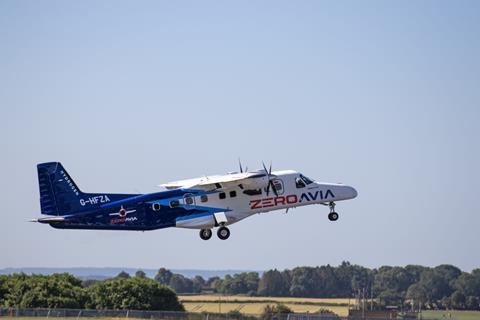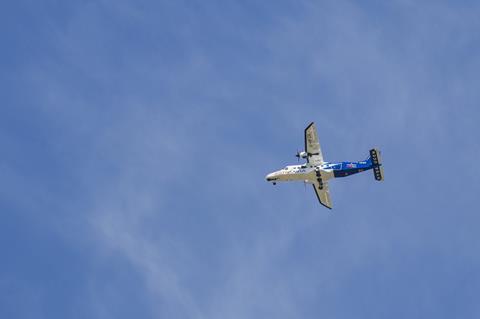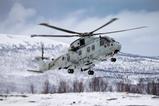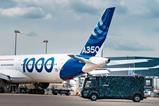Hydrogen propulsion developer ZeroAvia is readying its converted Dornier 228 demonstrator for the next round of test flights, as it prepares to submit its certification proposal for the ZA600 powertrain to the UK regulator.
An initial test phase using the Do 228 (G-HFZA) concluded in July, with the modified turboprop having completed 10 short sorties, each no longer than 30min, from its Cotswold airport base in the UK under a permit to fly from the Civil Aviation Authority (CAA).

Achievements since the January first flight included operating solely using the 600kW ZA600 hydrogen propulsion system and at the maximum altitude and speed – 5,000ft and 150kt (280km/h) – allowed by the CAA.
But ZeroAvia is moving towards the next stage of testing, expected to begin in late 2023 or early 2024, during which it will likely perform point-to-point flights, in part to assess its ability to refuel the aircraft away from its base, chief executive Val Miftakhov tells FlightGlobal.
“We have the aircraft ready for the continuation of testing – and that will probably be A to B, we’ll start flying into other places. We are waiting on the CAA to approve that,” he says.
ZeroAvia will keep the Do 228 in its current configuration, maintaining the maximum flight duration of around 30min. “Then we’ll see what we want to do to increase the range.”
Modification of the twin-engined Do 228 has involved replacement of its left-hand Honeywell TPE331 turboprop with a 600kW electric motor partly powered by fuel cells running on gaseous hydrogen.
For the prototype ZA600 powertrain, the fuel cells, their balance of plant, fuel tanks and batteries – which supply extra power to the propulsion system on the test aircraft – are all located inside the fuselage.
The range limitation is largely driven by the size of the fuel tank, says Miftakhov, but is sufficient for the current testing requirements: “It gives us all the data we need to inform the final configuration of the powerplant and submit it for certification.”
ZeroAvia has previously disclosed that the Cessna Caravan will be the launch aircraft for the ZA600 system and it expects to fly the first converted example “not too late next year”.
However, it will first seek a separate certification for the powertrain and will shortly submit its application to the CAA. “It will happen this quarter,” says Miftakhov.
Conversion of the Caravan – and of other in-production aircraft in future – will be covered by supplemental type certification which will be worked on concurrently. Service entry is targeted for late 2025.
While the Do 228 demonstrator has most of the hydrogen powertrain within the fuselage, cabin space will be needed for passengers or freight in commercial service.
The Caravan benefits from a large engine bay in its nose that can accommodate the electric motor – comprising four electrical machines – gearbox, compressor and fuel cells, while the hydrogen fuel tanks will be housed in its optional under-body cargo pod.
But a longer-range version using wing-mounted “extension tanks” is also being proposed to operators as a future option, says Miftakhov: “It will be something that certain customers want.”

He is also convinced that locating the fuel tanks beneath the fuselage will not pose a safety risk. The tanks themselves are “pretty sturdy”, and it is, he says, “likely to be the most structurally-sound part of the aircraft”.
Besides, ZeroAvia is also collaborating with Cessna owner Textron Aviation on the conversion programme: “We are not just doing it ourselves,” he says. “We have a partnership with those guys for the joint design and certification.”
Miftakhov also confirms the Cessna’s propulsion architecture will be battery-free: although the cells have been used to provide “increased redundancy” for the demonstrator – directly powering two of the motor’s four electrical machines – “the certificated version will not have batteries”, he stresses.
However, given the volumetric challenges of gaseous hydrogen – there is a limit to much you can squeeze into an existing airframe – there will be a penalty, particularly on range, versus a conventionally powered aircraft.
“About half the range of the maximum is what is realistically achievable with the first-generation [powertrain],” says Miftakhov. “But with most of these propeller planes, even large ones like the Dash 8 or the ATR, half the range is a good number [for operators].”
Cessna lists the Caravan’s maximum range as 1,070nm (1,982km) with a useful load of 1,500kg (3,300lb). “We are pushing for preserving the payload with about half the range of the fossil fuel engine,” he adds.
In the meantime, ZeroAvia continues to discuss with its customers as to which one will be the launch operator.
“There are a number of customers we have signed up but they are not sequenced yet on the deployment or production timeline,” it says.
“They have made some commitments on the number of engines or number of aircraft – and we are now sequencing them – deciding who’s going to be first.”
ZeroAvia is flying the Do 228 under a UK government-backed project called HyFlyer II, which is designed to position “the country’s aviation industry for the next century of aviation”.
Launched in December 2020, the three-year effort was supposed to culminate in “a 300nm zero-carbon flight of a 19-passenger aircraft”. However, ZeroAvia says the project’s goals “were changed to focus on specific element of hydrogen powertrain research and technology maturation up to technology readiness level 6.
“ZeroAvia is using its own capital, outside of the funded HyFlyer II work, to develop the product and achieve target market parameters which remain in line with these figures.”
But even after the end of the HyFlyer II programme, ZeroAvia will continue to use the Do 228 as a flying testbed.
“It’s a great test platform, we are putting some new technology on it,” says Miftakhov. He declines to reveal what modifications are being contemplated beyond saying it involves “different fuel storage types”, raising the possibility of a switch to liquid hydrogen.































